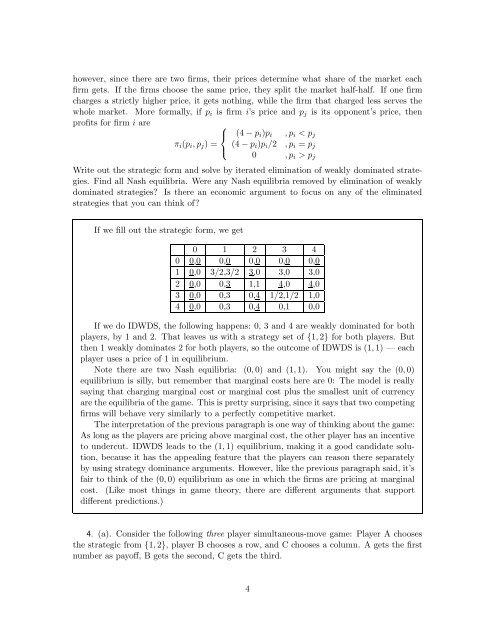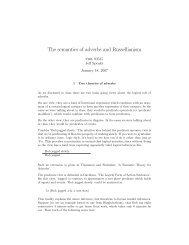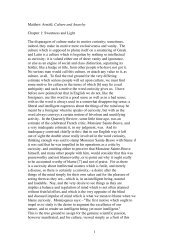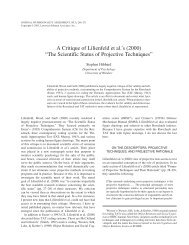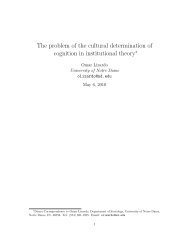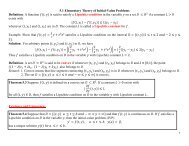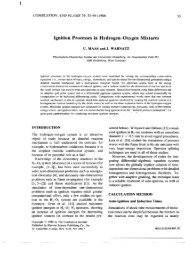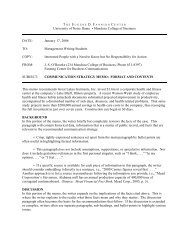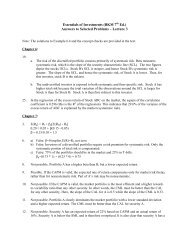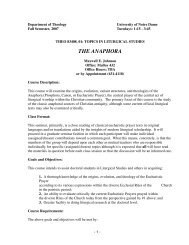Problem Set 1 1. Games in Strategic Form: Do questions 1-4 and ...
Problem Set 1 1. Games in Strategic Form: Do questions 1-4 and ...
Problem Set 1 1. Games in Strategic Form: Do questions 1-4 and ...
You also want an ePaper? Increase the reach of your titles
YUMPU automatically turns print PDFs into web optimized ePapers that Google loves.
however, s<strong>in</strong>ce there are two firms, their prices determ<strong>in</strong>e what share of the market eachfirm gets. If the firms choose the same price, they split the market half-half. If one firmcharges a strictly higher price, it gets noth<strong>in</strong>g, while the firm that charged less serves thewhole market. More formally, if p i is firm i’s price <strong>and</strong> p j is its opponent’s price, thenprofits for firm i are ⎧⎨ (4−p i )p i ,p i < p jπ i (p i ,p j ) = (4−p⎩ i )p i /2 ,p i = p j0 ,p i > p jWrite out the strategic form <strong>and</strong> solve by iterated elim<strong>in</strong>ation of weakly dom<strong>in</strong>ated strategies.F<strong>in</strong>d all Nash equilibria. Were any Nash equilibria removed by elim<strong>in</strong>ation of weaklydom<strong>in</strong>ated strategies? Is there an economic argument to focus on any of the elim<strong>in</strong>atedstrategies that you can th<strong>in</strong>k of?If we fill out the strategic form, we get0 1 2 3 40 0,0 0,0 0,0 0,0 0,01 0,0 3/2,3/2 3,0 3,0 3,02 0,0 0,3 1,1 4,0 4,03 0,0 0,3 0,4 1/2,1/2 1,04 0,0 0,3 0,4 0,1 0,0If we do IDWDS, the follow<strong>in</strong>g happens: 0, 3 <strong>and</strong> 4 are weakly dom<strong>in</strong>ated for bothplayers, by 1 <strong>and</strong> 2. That leaves us with a strategy set of {1,2} for both players. Butthen 1 weakly dom<strong>in</strong>ates 2 for both players, so the outcome of IDWDS is (1,1) — eachplayer uses a price of 1 <strong>in</strong> equilibrium.Note there are two Nash equilibria: (0,0) <strong>and</strong> (1,1). You might say the (0,0)equilibrium is silly, but remember that marg<strong>in</strong>al costs here are 0: The model is reallysay<strong>in</strong>g that charg<strong>in</strong>g marg<strong>in</strong>al cost or marg<strong>in</strong>al cost plus the smallest unit of currencyarethe equilibriaof the game. Thisis pretty surpris<strong>in</strong>g, s<strong>in</strong>ceit says that two compet<strong>in</strong>gfirms will behave very similarly to a perfectly competitive market.The <strong>in</strong>terpretation of the previous paragraph is one way of th<strong>in</strong>k<strong>in</strong>g about the game:As long as the players are pric<strong>in</strong>g above marg<strong>in</strong>al cost, the other player has an <strong>in</strong>centiveto undercut. IDWDS leads to the (1,1) equilibrium, mak<strong>in</strong>g it a good c<strong>and</strong>idate solution,because it has the appeal<strong>in</strong>g feature that the players can reason there separatelyby us<strong>in</strong>g strategy dom<strong>in</strong>ance arguments. However, like the previous paragraph said, it’sfair to th<strong>in</strong>k of the (0,0) equilibrium as one <strong>in</strong> which the firms are pric<strong>in</strong>g at marg<strong>in</strong>alcost. (Like most th<strong>in</strong>gs <strong>in</strong> game theory, there are different arguments that supportdifferent predictions.)4. (a). Consider the follow<strong>in</strong>g three player simultaneous-move game: Player A choosesthe strategic from {1,2}, player B chooses a row, <strong>and</strong> C chooses a column. A gets the firstnumber as payoff, B gets the second, C gets the third.4


